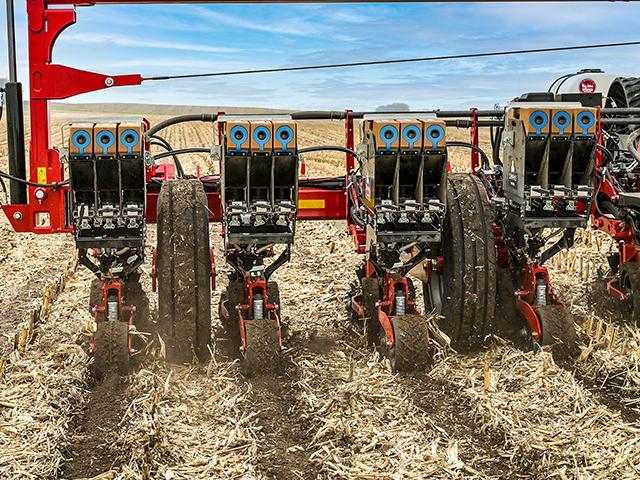Technology in the Trench
Art of Planting - Technology in the Trench
The furrow used to be a lonely place to grow -- a dark, potentially treacherous trench where solitary seeds began life.
Not anymore.
Today, corn hybrids and soybean varieties are far from alone when they're dropped into the furrow. Clad in the armor of multiple crop-protection products, they're often accompanied by a shot of nutrition in the form of starter fertilizer or micronutrient packages.
The furrow fellowship doesn't end with fertility. Whether in granular or liquid form, insecticides, fungicides and nematicides might also be invited to the party, along with inoculants, soil amendments and any number of biologicals.
Together, these products are intended to allow each plant to reach its highest yield potential and provide the grower with the greatest return on investment (ROI). While these in-furrow options are quickly growing in popularity, the ever-expanding list can be overwhelming.
"Right now, there are more than 400 biological companies out there in the market, and they all have their own unique set of bugs or their own unique strains of a set of bugs that act differently," says Jim Lappin, director for the SIMPAS product portfolio at AMVAC. "We talked to seed companies that want to put as many as 13 different components in their seed treatment. It's a little bit daunting."
Lappin says that overall, in-furrow products fall into two broad categories: products that are applied preventatively, such as insecticides or nematicides, intended to protect the crop from potential injury during the growing season; and products that are applied opportunistically, such as fertilizers and biologicals, intended to reduce yield-limiting factors and allow the crop to express its full potential.
"With the fertility products, it's really about efficiency, getting the right product in the right place at the right time at the right rate, the 4Rs," Lappin says. "You're taking an input and focusing it where you think you get the greatest benefit."
Jason Webster, commercial agronomist at Precision Planting, agrees. "There is an efficiency, around 25% to 30%, going from broadcast application of a dry fertilizer to an in-furrow band," he says. "It allows you to back down your rate in the fall and reallocate, so you're not over-applying fertilizer and you're not overspending."
FUNDAMENTALS FIRST
While in-furrow inputs may offer increased opportunities for healthier plants, higher yields and greater ROI, growers shouldn't let their addition to the planting operation distract from core agronomic principles. Webster says that no matter how many products are placed in the furrow with the seed, none are a substitute for planting into fit conditions with proper singulation, depth and downforce.
P[L1] D[0x0] M[300x250] OOP[F] ADUNIT[] T[]
"You could be using the absolute best starter fertilizer, but if you don't have proper planting depth and you're putting seeds in dry dirt, that fertilizer is not going to do anything for you at all," he explains. "If you have a high percentage of residue in the trench reducing seed-to-soil contact, or your closing wheels aren't doing their job, there isn't a starter fertilizer product that can fix that for you.
"Your row units need to be dialed in, and once they are, then you can start thinking about adding tanks and pumps for some of these in-furrow systems," Webster says.
SELECTING SYSTEMS
When outfitting a planter with an in-furrow application system, farmers have a growing list of options. There are systems on the market that deliver liquid products, systems that deliver granular products and some that deliver both simultaneously.
Some apply product directly on the seed whereas others place the input in proximity to the seed within the sidewall of the furrow. Some apply product in a linear band and some deliver product in pulses. Some can even deliver prescriptive applications as the planter moves across a field.
Webster recommends growers consider the overall yield limitations in their fields, then choose a system to overcome that limitation.
"What do your fertility numbers look like? Is phosphorus the yield-limiting factor?" he asks. "If it isn't, you may not have to focus as much on 'near seed or in-furrow' type application equipment on the planter."
Fertility is not the only yield-limiting variable that can be addressed with an in-furrow system, however.
"If I'm planting corn in an 'I' state, for example, I'm probably dealing with corn rootworm pressure," Lappin says. "While there are lots of solutions for that issue, delivering an in-furrow insecticide with a system like SIMPAS can help address it."
AVOID IN-FURROW FOLLIES
Both Webster and Lappin say that once a system is selected, growers need to understand the products they're using and how they might interact with both the seed and each other.
"We've been guilty of turning product into cottage cheese on the planter before because we didn't do our due diligence," Webster says. "If you're going to put more than one product together in the same tank, do a jar test and make sure everything is compatible."
This is especially important as growers incorporate more biologicals. These products contain living microbes, and Lappin says many are not tolerant of the high salt content found in many fertilizers.
"When you're delivering a live microbe to the soil, you want to make sure that it's being placed in proximity to the seed and in an environment where it can thrive," he says.
At Precision Planting's research farm in central Illinois, Webster says they use the company's FurrowJet in-furrow application system to deliver biologicals on the seed while directing starter fertilizers to the sides of the trench. "We keep them all separate to make sure everybody plays nice," he adds.
Chloride-based fertilizers also can steal away moisture from the seed and potentially reduce germination, Webster notes. With a grower's substantial investment in tanks, pumps and an in-furrow application system -- not to mention the cost of seed -- it's important to understand all the risks that come with the potential rewards.
"When you go in-furrow, the risk is a little higher," he says. "We want to make sure that whatever systems and products we choose, it's bulletproof."
**
-- Follow Jason on Twitter @JasonJenkinsDTN
[PF_0223]
(c) Copyright 2023 DTN, LLC. All rights reserved.




